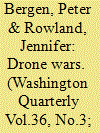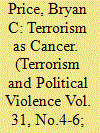| Srl | Item |
| 1 |
ID:
124841


|
|
|
|
|
| Publication |
2013.
|
| Summary/Abstract |
At the National Defense University (NDU) on May 23, 2013, President Barack Obama gave a major speech about terrorismarguing that the time has come to redefine the kind of conflict that the United States has been engaged in since the 9/11 attacks. Obama asserted that ''[w]e must define the nature and scope of this struggle, or else it will define us.''1 Thus, the President focused part of his speech on the Authorization for the Use of Military Force (AUMF), which Congress had passed days after 9/11 and which gave President George W. Bush the authority to go to war in Afghanistan against al-Qaeda and its Taliban allies. Few in Congress who voted for this authorization understood that they were voting for what has become the United States' longest war, one that has expanded in recent years to countries such as Pakistan and Yemen
|
|
|
|
|
|
|
|
|
|
|
|
|
|
|
|
| 2 |
ID:
169925


|
|
|
|
|
| Summary/Abstract |
This paper provides an alternative framework that conceptualizes the threat posed by terrorism based on an epidemiological approach that views it as a chronic disease like cancer rather than as a military, ideological, or socio-economic problem. After highlighting the similarities in the causes, behavior, treatments, and challenges of combating terrorism and cancer, this paper presents a staging system policymakers can use to educate the public and allocate counterterrorism resources more efficiently. This approach encourages policymakers to see terrorism for what it is (an all but inevitable facet of modern life that can be managed but never fully eliminated), and not what they wish terrorism to be (a national security problem that can be solved, defeated, or vanquished). It provides policymakers with a useful model to conceptualize the threat and treat terrorism in a comprehensive manner, from preventing future attacks to effectively responding to them when they will inevitably occur.
|
|
|
|
|
|
|
|
|
|
|
|
|
|
|
|